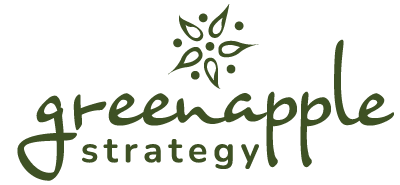If 2025 taught marketers anything, it’s that nothing stays the same for long. Between AI advances, algorithm shake-ups, and tighter budgets, marketing teams everywhere found themselves rethinking how to keep pace without losing their sanity.
As you head into 2026, you might feel a little whiplash from all the changes. You might be asking yourself: What is actually possible for my team to implement?
At Green Apple Strategy, we approach our work with creativity, clarity, and care. That means helping our clients stay curious about what’s next while staying realistic about what’s doable. You don’t have to chase every shiny new idea. You just have to know which ones matter most for your brand and your audience.
7 B2B Marketing Trends to Watch in 2026
We sat down with our strategists and Orchard members to identify the marketing trends we encourage our small to mid-size B2B clients to consider. Whether you’re a marketing team of one or a growing company with outside agency support, here are seven key trends we’re watching for 2026—plus one simple, actionable idea you can test tomorrow.
1. The Shift From SEO to AEO (Answer Engine Optimization)
Notice a shift in the way Google responded to your search requests in 2025? That’s because search engines aren’t just engines anymore—they’re answer hubs. With AI-driven tools like ChatGPT, Perplexity, and Gemini, the way people search for information is evolving. That means your content needs to be written for humans and large language models (LLMs) that are sourcing answers from trusted, well-structured content.
If you want to be “findable” in the AI era, focus less on keyword stuffing and more on credibility, clarity, and authority. Think detailed guides, cited sources, and content that clearly answers a question.
Test this tomorrow: Pick your most-visited blog post and give it an “AI-friendly” update. Add clear subheads, structured data (like FAQs), and a quick summary that directly answers the post’s main question.
2. AI Usage Policies: Setting Boundaries and Building Trust
AI has become a coworker for nearly every marketer. From brainstorming ideas and improving meetings to enhanced customer engagement tactics, AI tools have become part of the daily workflow. But with great power comes… a little chaos.
As AI adoption grows, so does the risk of inconsistent brand voice, potential copyright issues, and accidental misinformation. Creating an internal AI usage policy helps your team (and partners) stay consistent, ethical, and efficient.
Test this tomorrow: Start a shared document titled “AI Use Guidelines.” Jot down what’s okay to use AI for (like brainstorming headlines) and what still requires human oversight (like client-facing copy).
3. Google Business Profiles Are the New Local SEO Secret Weapon
Google recently confirmed that regularly updated business profiles garner more visibility in search results. For B2B brands, this is low-hanging fruit that’s often ignored.
Treat your Google Business Profile like a mini social channel. Regularly post updates, add fresh photos, and share company news or wins. It signals that your business is active, engaged, and trustworthy.
Test this tomorrow: Log into your Google Business Profile and post a behind-the-scenes photo, recent client award, or team highlight. Then, set a reminder to do it again next week.
4. Experiential Brand Building Increases in the B2B Space
By 2026, brand awareness won’t cut it. Buyers want to feel something. The brands that win will be those that connect through experiences, whether that’s an immersive digital campaign, an in-person event, or a story that sticks.
At Green Apple, we’ve seen firsthand how this shift is transforming B2B marketing. People remember how your brand made them feel far longer than they remember what you said.
Test this tomorrow: Audit your next marketing campaign. Where can you add a small “moment of delight”? Maybe it’s a handwritten note in a direct mail piece or a video message instead of a plain email.
5. Digital PR Is Becoming Essential for Brand Reputation
AI and algorithmic search rely on authority signals. One of the best ways to build brand authority is through credible, earned media. Digital PR needs to share stories that other trusted sources want to talk about.
PR coverage in the age of AI not only boosts visibility, but it also helps AEO search engines (and your audience) see your brand as a trusted thought leader.
Test this tomorrow: Identify one publication or industry blog your audience reads. Brainstorm a story idea that ties your brand to a larger trend or insight. Then pitch it or partner with a local PR agency that can help.
6. The Smart B2B Content Shift
The days of “publish or perish” are over. What’s working now is intentional, high-value content that builds trust over time. Instead of cranking out endless blog posts, B2B marketers are focusing on comprehensive resources, useful tools, and video content that support real buyer needs.
Repurposing is also key. A single podcast can become short audio clips, testimonial graphics, and a blog post, giving you more value from every piece.
Test this tomorrow: Look at your analytics and find your best-performing piece of content. How can you repurpose it into three new formats next month?
7. Smarter Email Segmentation for Better Lead Nurturing
Email still delivers one of the highest ROIs in marketing, but it’s evolving fast. Smart segmentation and behavior-based automation are making email more personalized (and less spammy).
In 2026, the most effective email strategies will feel like conversations, not campaigns. Using tools like HubSpot, Mailchimp, or Campaign Monitor, marketers can tailor messages by interest, location, or engagement level instead of sending the same message to everyone.
Test this tomorrow: Create one new segment in your email platform (e.g., customers who opened your last three emails but haven’t clicked). Send them a message that asks a simple question or offers something specifically targeted to that audience.
Closing Thoughts: Small Steps, Big Results
Trends can feel overwhelming, especially when you’re a marketing team of one (or two). But the truth is, you don’t have to do everything at once. The key is to start small, test often, and stay curious.
If you need a partner to help you cut through the noise and create a marketing plan that’s both strategic and achievable, Green Apple Strategy is here to help. Learn more about our strategic planning services to help make 2026 the year your marketing feels less chaotic and more effective.











